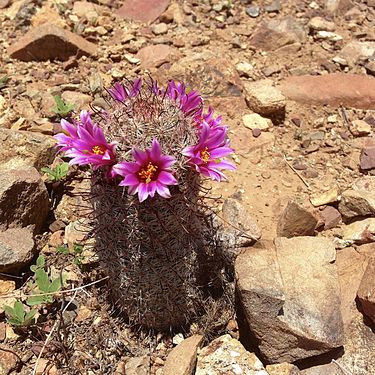Cochemiea grahamii is a species of cactus also known by the names Arizona fishhook cactus[2] and Graham's nipple cactus.[3]
Description
Cochemiea grahamii grows either solitary or branching from the base, with thickened roots and hooked stems. Its spherical to short cylindrical light green shoots reach heights of 7 to 20 centimeters, sometimes more, and have diameters of 7.5 to 11 centimeters. The plant has cylindrical to egg-shaped, often square, warts that lack milky juice, with naked axillae. It has 1 to 4 central spines that are yellowish-brown to dark brown, measuring 1.2 to 2.5 centimeters long, with the longest usually being hooked. There are also 20 to 35 straight, needle-like marginal spines, white to light brown or reddish, 0.6 to 1.2 centimeters long.
This cactus has flowers pink or lavender in April and May.[4] The flowers range from lavender-pink to reddish purple, sometimes white, and are 2 to 4.5 centimeters in diameter. The almost spherical, red fruits are 1.2 to 2.5 centimeters long and contain black seeds.[5]
Distribution
Cochemiea grahamii is found in Arizona, California, New Mexico, and Texas in the United States,[4] and in Sonora, Sinaloa, and Chihuahua in Mexico at elevations of 200 to 1800 meters growing in dry habitat of gravel or grassland, desert mountains, sandy or rocky canyons, washes and plains on igneous or limestone substrate.[4] Plants are found growing among Larrea tridentata or in grasslands.[6]
-
Plant growing near Saguaro National Park
-
Plant growing in Luna County, New Mexico
Taxonomy
Originally described as Mammillaria grahamii by George Engelmann in 1856, the specific epithet honors American topographer Colonel James Duncan Graham (1799–1865), who led the scientific corps surveying the US-Mexico border.[7] Alexander Borissovitch Doweld reclassified the species to the genus Cochemiea in 2000.
References
- ^ "Cochemiea grahamii (Engelm.) Doweld". Plants of the World Online. Royal Botanic Gardens, Kew. Retrieved 17 January 2024.
- ^ "Mammillaria grahamii Engelm". Global Biodiversity Information Facility. Retrieved 2024-01-17.
- ^ "PLANTS Profile for Mammillaria grahamii". USDA Plants Database. USDA. Retrieved 17 April 2013.
- ^ a b c "Mammillaria grahamii". Lady Bird Johnson Wildflower Center. Retrieved 17 April 2013.
- ^ Anderson, Edward F. (2011). Das große Kakteen-Lexikon (in German). Stuttgart (Hohenheim): Ulmer. p. 383. ISBN 978-3-8001-5964-2.
- ^ "Cochemiea grahamii". LLIFLE. 2013-08-04. Retrieved 2024-05-25.
 This article incorporates text from this source, which is available under the CC BY-SA 3.0 license.
This article incorporates text from this source, which is available under the CC BY-SA 3.0 license.
- ^ Arts, American Academy of (1852). "Proceedings of the American Academy of Arts and Sciences". Metcalf and Co. ISSN 0199-9818. Retrieved 2024-05-25.
External links
 Media related to Cochemiea grahamii at Wikimedia Commons
Media related to Cochemiea grahamii at Wikimedia Commons Data related to Cochemiea grahamii at Wikispecies
Data related to Cochemiea grahamii at Wikispecies- Calflora Database: Mammillaria grahamii




Recent Comments